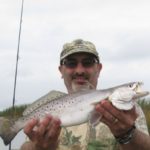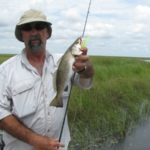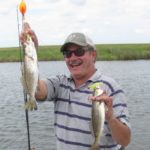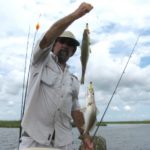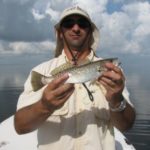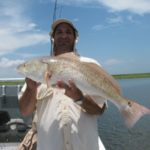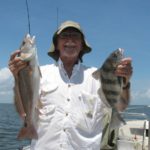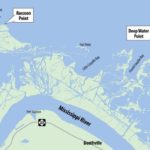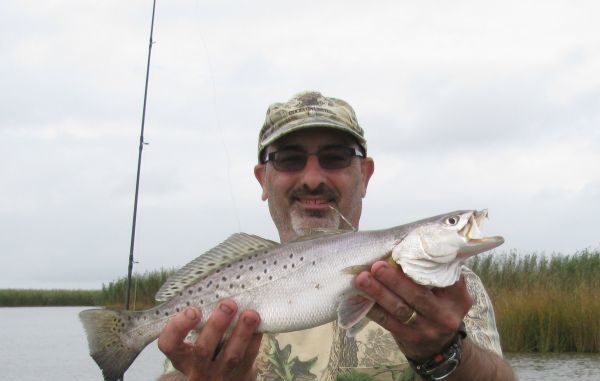
Dodge the armadas launching from Venice and Pointe a la Hache by heading to the midway point to find trout and reds that rarely see lures.
The whole-fried “cigar trout” from the Easter bash made quite a hit. Nana Fontaine (Doc’s Mom) raved loudest, of course.
But she’d been the one who put in the special order for them.
“Just like the ones we used to get at Fitzgerald’s in West End!” she gushed while squeezing lemon on the crispy, garlicky skin of her second or third one. “And like the ones your father would always bring home from Dela-Crow Island!”
“But Mitch (Doc’s real name) never gets me any! What with dat silly fly-fishing of his! And dat silly catch-and-release fishing of his! Shoot, Mitchie spends more money on his boat than what cost da house he was born in — a shotgun house in the Irish Channel. And me — his mama — am doggone lucky if I EVER get any fish nowadays!”
Doc looked around sheepishly as Trisha piled on.
“That coo-bee-yon dish with the redfish was also great,” Trisha said. “You gotta make that again, Nana! And don’t worry — I’m not throwing back any more of those ‘dinks,’ as Mitch calls ’em. Not if they’re 12 inches!”
“Your father never used dem silly fly-fishing pole things!” Nana added. “When he went fishing — which was every weekend — he went FISHING! He brought home fish! He always laughed at dem silly fly-fishing tings — called dem ‘those Yankee fishing thing-a-ma-jigs!’ Like that fella on TV always used —dat fella with the fishing show — who went around in a little plane? What was his name? Gad …?”
“Gaddabout!” Pelayo blurted. “Gaddabout Gaddis! The flying fisherman.”
“Yeah dat was him!” Nana laughed. “He always used dem silly fly-rod tings. Your father would watch him and laugh and laugh. Oh he’d laugh himself silly! ‘Look at those fish he catches,’ your father would say. ‘Look at dem little- biddy trout he catches in dem Yankee streams — and he’s frying em up!’
“And, heck, your father would laugh. ‘Dey ain’t no bigger than the cocahoe minnas we use for bait down at Da Island!’”
“No problemo, Nana,” Pelayo said, while walking over and grabbing Nana’s hand as she looked up and smiled. “We’ll get you some fish this week. You can bet on it.”
“Gene wants to go, too” Trisha whispered to Pelayo while pointing at the elegant gentleman conversing with Spencer near the 4–point fajita platter.
Ah, yes, for most of the evening we had been wondering about this dapper fellow. While chitchatting with him, you see, his questions had seemed genuinely inquisitive rather than rhetorical? Then he actually listened to the answers, calmly and earnestly.
More bizarrely still, he smilingly admitted to much ignorance on several subjects. We were all puzzled upon noting that his tone of voice and facial expression were utterly free of cynicism.
And as crazy as it might seem, he did not boast expertise in every field of human endeavor from hunting to fishing, from frogging to spear-fishing, from football coaching to baseball coaching and from hydromechanics to microbiology.
Crazier still, his demeanor and manner of speaking revealed no trace of bravado or know-it-allism.
There seemed only one explanation for this perplexing speech and behavior pattern: We saw no alternative to concluding that this strangle fellow just had to be from out-of-state.
Sure enough. Gene was Trisha’s cousin visiting from Long Island for Nana’s 85th birthday bash. He was also an amateur photographer and was keen to click away at Louisiana’s famed wetlands.
So he seemed the perfect guest for our fishing trip to the area stretching roughly from Ostrica to Grand Bay on the East side of the Mississippi River Delta.
In fact, we’d be fishing near some of Southeast Louisiana’s most historically famous speck landmarks — The Black Tank, Sable Island, Bird Island, Raccoon Point, Battledore Reef, Deepwater Point, Taylor’s Point.
Alas, the Black Tank, Battledore Reef, and Sable and Bird islands “ain’t dere no more.” But Deepwater, Fort and Taylor’s Point remain — though somewhat changed from their 1970-80s heyday.
And, though the speck fishing in the area has certainly been disrupted, it has not been damaged.
“Disrupted” means that, with all the cuts from the river into this section of marsh nowadays, during the spring and early summer high-river months the specks generally hang much farther out into Breton Sound in the saltier waters.
“Hardly-damaged” means that when the river drops in late summer and fall the speck fishing actually comes back as hot (probably hotter) than during By Hek days.
In fact, you can really “put the ants on ’em!” in the area, especially under birds.
And the fishing tends to be much closer in — along the very shoreline, in fact. This means when you take off from the marina “like a striped ape” you don’t have to haul nearly as far to catch specks as we did when Hap Glaudi gave Bill Kilmer’s passing average and our poles were rigged with smoky shrimp-tails and specks a go-go.
And the fishing panorama doesn’t get any more picturesque than this area nowadays. Gene would have plenty of fodder for his camera.
The lush wetlands that have sprouted as a result of the river spillways mean we’d be amidst much more than exposed mud and sparse spartina grass.
Instead, in some areas, we’d be surrounded by roseau, willow, elephant ear, delta duck potato, three square and cattails — in brief, everything that used to grow almost exclusively south of Baptiste Collette.
Ospreys, roseatte spoonbills, skimmers, night herons, otters and alligators are some of the fauna on which Gene could expect to focus his lens. In fact, many more of these species now inhabitant this area then back when Nash Roberts gave us the latest hurricane forecast and our poles were rigged with Mr. Champs and shad rigs.
The boat trip from Riverside in Buras lasted no more than 15 minutes three days later, and we promptly starting drifting and casting blindly through a current line broken by little splashes about 100 yards from the shoreline of what used to be known as Raccoon Point.
The splashes appeared to be pogies and a few small schools of mullet cruised around, the tops of their heads poking above the calm waters.
A stiff west wind — so detrimental to most fishing in Southeast Louisiana — made for calm conditions in this lee side of the river.
“Yeah!” Pelayo yelled from behind me, and I turned around to see his pole deeply bowed. “Yep! Same ol’ Raccoon Point!”
A little speck hit the surface in a gill-rattling frenzy; we’d been fishing all of five minutes.
Never fails around here this time of year, and always on the basics — popping corks 3 feet above white-and-green beetles.
But remember, we’re talking school trout here.
Me, I still like my tandem shad rig — the little ones in yellow and white. They caught trout for me in 1968, and they still catch them today.
I rigged my shad rigs about 3 feet under a popping cork and cast toward a little swirl.
The cork never stopped. It hit the water and kept going down. I thought it might have gotten tangled for a second, as happens a lot with tandem shad-rigs.
Then I felt the jerk.
“Oh yeah!” I said as I reared back and another lunge almost jerked the rod from my sweaty grip.
The drag was loose and singing crazily as I cranked away. Finally, the fish went airborne — a complete flip, like a dolphin.
“Saw that?’ I howled and looked around.
No one had.
Pelayo, Artie — and even Gene — were busy fighting fish.
Gene’s was thrashing the surface now, rattling that yellow mouth like castanets, sending up a gorgeous froth of water. We were wailing on ’em.
“Yeah you rite!” Pelayo howled from the bow. “Gotta DOUBLE here!”
And he looked over with a lunatic grin as BOTH his fish went berserk on the surface, one finally jumping off the hook.
“AW, MAN! Pelayo roared. “Saw that?”
Gene was in hysterics. He’d never experienced fishing like this.
“You’d think you guys had never fished before!” he laughed. “And from everything I hear from cousin Trish, that’s hardly the case!”
Gene had a point. A school speck frenzy still does that to us. It did it on the Metairie lake shore in 1969, and it does it along Raccoon and Deep Water points today.
Fish this marsh (roughly from Raccoon Point on the north to Deepwater Point on the south) on a high (the higher, the better) and falling tide, and you can’t go wrong — especially for reds.
The trout seem less finicky about tide direction, so long as it’s moving.
Also throw in some puppy drum, flounder, sheepshead and a smattering of white trout for the entire picture in this area.
Most people who launch from Venice and cross the river fish up to Taylors Point, maybe Deepwater Point. Those who launch from Pointe a la Hache, fish down to Spanish Pass or California Point.
Those who launch into the river at Buras generally cross the locks and keep heading out to Battledore or Breton Sound.
Obviously, exceptions exist, but the pattern seems to hold, in our experience.
Fine. Be our guest. That’s the beauty of this section of marsh — no crowds.
And this is a pretty big section of marsh to fish almost unmolested.
That’s another beauty of this area in late summer and early fall — the options. You can go from casting live bait or plastics around a well in Breton Sound to cork fishing with tandem beetles under birds around a Fort or Deep Water points to fishing around the spartina or roseau shoreline of Grand Coquille Bay for reds, flounder and puppy drum — all in a couple of hours without traveling more than a few miles.
After a mere dozen specks, our first bite ended. For Gene, the trip was already a rollicking success—but suddenly he pointed south.
“There’s some of those birds, you guys were talking about!” he said.
“Birds, alright,” Pelayo smirked. “But those are pelicans. We wanna see black-headed gulls, either hovering or just sitting in da waaaw-dah. That usually signals a school of feeding specks below.”
“But no problemo, Gene,” a suddenly amiable Artie said. “You probably want some pictures of those pelicans, right? OK, let’s go.”
And he gunned the gas toward the action. Four casts (for the heck of it) produced exactly what we figured: thee gafftops — but with the added excitement (and photo op for Gene) of a little bullshark.
We were cruising south along the edge of Breton Sound when Gene pointed again. “Aren’t those …?”
“You catch on quick, amigo!” Pelayo laughed.
“Well,” Gene smiled. “I am an amateur birdwatcher of sorts.”
Indeed he’d spotted the black-headed gulls both sitting in and hovering over a slick area about 400 yards between Deepwater and Coquille points. So off we went, killing the motor about 100 yards from the birds and drifting in.
“YES SIREE!” yelled Gene, who was actually first to cast here and quickly hooked up with his tandem beetles. “Geezum! Almost like a bluefish frenzy off Montauk back home!”
We landed another 23 specks while following these birds. Then it was time to head inland a bit and introduce Gene to some reds.
Artie sent a shrimp-tipped beetle 2 feet under a popping cork to the grassy tip of a feeble spartina-grass point backed up by a wall of roseau midway into Grand Coquille Bay. The place had redfish written all over it.
The cork splashed about 2 feet from a white PVC pole and disappeared.
“Hey what the …?” Artie frowned, mumbling something about his twisting line when — “WHOA! Dat’s him!”
He reared back on the light-action rod, his vintage Mitchell 300 immediately beginning to sing — and the battle was joined.
No tight drags and stiff bass rods for us. We like to play fish, to feel those lunges, to savor the screeching runs of a berserk red in shallow water.
And, mostly, to listen to the scream of a loose drag on a spinning reel.
Artie’s pole seemed on the verge of splintering, and his face was a mask of sheer delight as that bronze torpedo blazed through the shallows. From its wake, you could tell it was a beauty. Probably 5 to 7 pounds.
I grabbed the net just as Pelayo let out a yell. He was on one, too, and Gene was again whooping to the heavens as he set the hook.
I netted Gene’s red to a chorus of hurrahs accompanied by high-fives as Pelayo placed his puppy drum along the “Cajun Computer,” stretching it, closing its tail for that extra half inch.
“Aha!” he beamed. “Eighteen and one-quarter inches — a keeper.”
Eight more reds from 18 to 23 inches soon filled the da box from similar spots in this area, with four puppy drum and two (not quite) doormat flounders rounding out the day’s catch.
We encountered only one other boat while fishing. But when heading back, a parade of them were coming in from the open waters of Breton Sound.
We weren’t remotely close to limits, but Gene was elated (and so were we.) On the ride back, Gene couldn’t stop raving about the fabulous time he had.
And Nana had all the ingredients she needed for a rollicking birthday bash.
